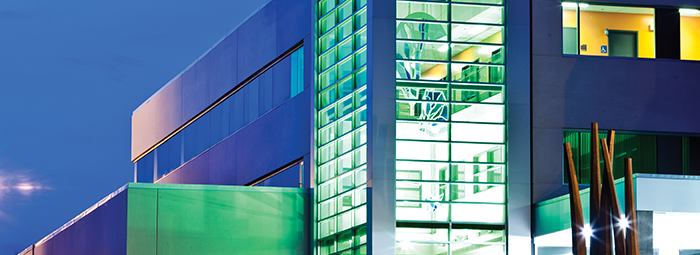
©2020 This excerpt taken from the article of the same name which appeared in ASHRAE Journal, vol. 62, no. 11, November 2020.
About the Author
Olivier Matte, Eng., is director of technical communications for Ecosystem, Quebec City, QC, Canada.
The Université du Québec à Trois-Rivières (UQTR) has long been committed to energy efficiency. Its energy management team recognized that one of the main hurdles to additional energy savings was intrinsic to their district-heating network. These savings could only be achieved with a deep energy retrofit of the main campus. Today, following a high-performance retrofit, students and staff are proud that their university is more energy efficient and sustainable and has lowered itws greenhouse gas (GHG) emissions by 53%.
Located in Trois-Rivières, Quebec, Canada, the extensive campus (1,372,367 ft2/1,380,827 ft2 [127 543 m2/128 330 m2] gross surface) welcomes 14,000 students each term. The campus originally had a central heating loop with high-pressure, high-temperature water. This central loop passed its heat off to local building loops through heat exchangers. These building loops were at lower pressures and temperatures.
From 2010 to 2014, the university undertook a deep retrofit, partnering with an integrated design and construction firm. The project was implemented through an innovative energy performance contract that guaranteed key project outcomes.
The project began with a complete energy optimization of the demand across most campus buildings. Then, a complete reengineering of the district-heating network was performed. Existing satellite chiller networks were connected to the main cooling loop, maximizing heat recovery potential. These changes took place while the campus was operating normally, without significant disruption to campus activities. Converting the existing high-pressure, hot-water heating network to a low-pressure network eliminated major heat losses. It also presented the opportunity for efficient heat recovery using a centralized heat pump, taking full advantage of Quebec’s low hydroelectricity rates.
Innovation
With 15 complexes across the campus, recovering and transferring heat between buildings was both a challenge and the key to unlocking significant energy savings. Using a heat recovery heat pump was an effective strategy. However, the existing heating network was not compatible with this solution. It was a high-pressure, high-temperature hot-water network, with supply at 265°F (130°C) and return at 185°F (85°C). To enable the use of heat pumps, engineers converted the network to a low-temperature system, with a supply of 180°F (82°C) and return at 120°F (49°C). This complex conversion affected the entire heating system, so precise planning and construction management were paramount. Some of the challenges and solutions for this conversion included the following:
Reducing the pressure and temperature of the heating network, while supplying enough heat to match demand. High-temperature loads were eliminated with the removal of steam generators (which were used for humidification). In their place, independent gas-fired and adiabatic humidification units were installed. Equalizing the pressure between the campus-wide network and each building network allowed for the removal of heat exchangers, which further reduced the supply-temperature and pump-capacity requirements.
Ensuring the lowest possible return-water temperature to maximize usage of a new 200 ton heat recovery heat pump. To achieve this temperature, engineers reconfigured the network and set up as many heating loads in series (as opposed to parallel) as possible. The reconfiguration enabled a return temperature as low as 113°F. Four new 4 MBtu hot water boilers (one of which is a condensing boiler) were installed.
Read the Full Article
ASHRAE Members have free access to the full-text PDF of this article as well as the complete ASHRAE Journal archives back to 1997 in the Free Member Access Area.
Non-members can purchase features from the ASHRAE Bookstore. Or, Join ASHRAE!
Return to Featured Article Excerpts
Return to ASHRAE Journal Featured Article Excerpts